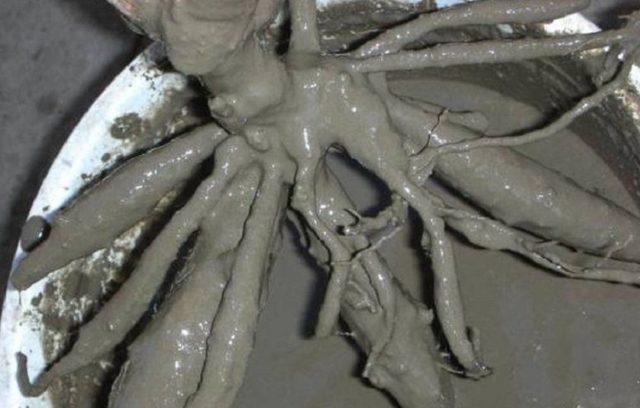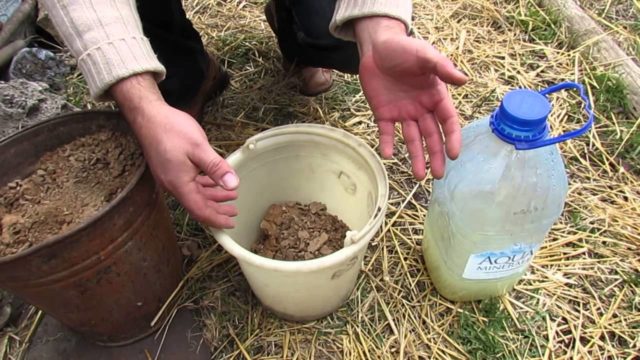Content
Clay talker is a very cheap, but effective and widespread remedy for protecting the bark and root system of trees from pests, fungi, burns and rodents. Most gardeners use a mixture made from clay, lime, hay, straw, copper sulphate and other ingredients in order to secure the harvest and increase the rate of fruiting.
Benefits of Clay Chatter for Trees
Clay talker - and an affordable remedy that is used to treat and protect fruit trees. The mixture is characterized by antiseptic properties. It is easy to prepare. Among the main advantages of the clay talker are:
- waterproofness;
- protection from sunlight, cold and chapping;
- protection against pests, pathogenic microorganisms and fungi;
- restoration of damaged areas;
- minimum costs for its creation.
It is recommended to prepare a clay talker for trees in order to protect the bark of fruit trees from rodent attacks. Despite the low cost of the composition and the simplicity of its preparation, this method is considered more effective and less harmful than special preparations that are sold in garden stores and are not cheap. The use of this affordable tool can significantly increase the survival rate of seedlings and extend the shelf life of root crops.
How to make a talker for trees
The Clay Chatterbox is easy to prepare and can be made from the available ingredients. Many gardeners, in addition to the main components, add growth stimulants, copper sulfate and other components to the mixture. A clay talker, prepared for the bark of an apple tree, allows you to heal both small wounds and fairly extensive injuries. The regenerative function of the mixture is achieved due to the presence of beneficial microorganisms with antiseptic properties and nourishing the bark with valuable minerals and microelements.
How to make a clay potter for seedlings
Prepare a clay mash for the roots to prevent them from drying out during transportation or transplanting. The chatterbox is made from water, earth and clay with the addition of sawdust, which stick to the roots and retain moisture. After processing, the roots must be wrapped in plastic wrap or burlap.

The root system of the seedling can be in a chatterbox for up to 7-8 days without the risk of drying out.
Before planting in the ground, the roots are removed from the coating by thorough rinsing.
Clay talker for whitewashing trees
It is recommended to make a clay chatter for trees so that the lime mortar does not drain from the trunk and provides reliable protection against insect pests and temperature changes. In the presence of deep wounds and damage to the tree, the trunk must be pre-treated with a 3% solution of ferrous sulfate.Then, a bandage should be applied to the problem areas, for the manufacture of which they take a cotton cloth or a bandage soaked in a clay talker. Do not make it out of silk or satin fabric and tighten it too tightly. The mixture can be supplemented with a small amount of cow dung.
Clay tree bark talker
You can prepare a clay talker to putty trees according to the following recipe:
- Slaked lime (no more than 2.5 kg), oily clay (1 kg) and copper sulfate (45-55 g) are poured into a bucket of water.
- All components are mixed until the lumps disappear completely and a homogeneous consistency is obtained.

The clay-lime mixture can be used to whitewash trees both in the spring and in the summer.
A properly prepared chatterbox should not spread along the barrel.
How to Prepare a Clay Shampoo for Slicing
A tree cut is an open door for a variety of pathogens and fungi. Untreated damage adversely affects growth and fruiting rates. You can prepare a clay talker for processing sections and cracks using the following technology:
- Mullein is mixed with clay in a 1: 2 ratio.
- A small amount of hay or chopped straw is added to the resulting mixture.
- Water is poured into the chatterbox and stirred until the consistency of thick sour cream.
Clay composition for sections is applied only to the damaged area. The edge of the damage must remain clean. The tree chatter recipe can be supplemented with other ingredients, but care must be taken to respect the proportions. Otherwise, the finished mixture may turn out to be too liquid and drain from the trunk or harm the bark (root system) due to too high concentration of additional components.
Terms and rules for processing trees with a clay talker
Before processing the tree with a clay mixture, it is necessary to clean the base of the trunk from lichen and remnants of exfoliated old bark. This manipulation is carried out manually, since plastic or metal scrapers can injure the tree. To clean cracks and grooves, it is recommended to use a wooden knife or a sharpened chip. It is necessary to get rid of unnecessary branches during pre-processing in dry weather, otherwise the cuts will take a very long time.
The next step is disinfecting treatment. It is also carried out exclusively in dry weather conditions without the threat of rain. For disinfection, a mixture is used that includes copper sulfate and other copper-containing preparations. When processing, they resort only to finely dispersed spraying, since the drops of the solution should simply settle on the surface of the bark and envelop it with a protective layer. Disinfection using a soap-ash infusion is considered effective.

To close up wounds and processing with a clay mixture, they proceed only after the completion of all preparatory manipulations
Whitewashing of trunks is done no more than three times a year: the main procedure is performed in the fall from October to November, the next one - at the very end of winter or with the onset of spring. The third whitewashing is carried out in mid-July, but some gardeners consider it unnecessary and are limited to two. The procedure is necessary for both young seedlings and adult trees. Some experts warn that whitewashing can harm annual crops due to the burning of the delicate bark.
The autumn procedure is considered the most important, since it protects the fruit tree from larvae, spores of various fungi, sunburn, temperature changes and other negative factors.
How to make a clay pot for storing root vegetables and flower tubers
With the help of a clay talker, you can save carrots, beets, celery and other vegetables until spring.After dipping, they must be dried and placed in a cellar or other suitable storage place. Thanks to the clay mixture, you can preserve the tubers of dahlia and other ornamental crops by bathing the planting material in a chatter box with the addition of manganese or copper sulfate. After the clay crust has completely dried, the tubers are placed in boxes and stored. With the onset of spring, you need to knock on the crust without significant effort to shed it.
Preservation with a mixture of clay allows you to preserve not only moisture, but also the taste of the root crop, vitamins and most useful components. Many gardeners find that by the spring a significant proportion of their beet or carrot stock is lost due to rodent attack. With the help of a clay mixture, you can easily prevent any invasion of the crop by a variety of pests.
Conclusion
Clay talker is a universal remedy for protecting fruit trees from fungi, mold, parasites, rodents, sunburn and weathering. The main advantages are ease of preparation and incredibly low cost of the mixture. With the help of a talker, you can not only secure the harvest, but also preserve root crops until spring, without losing their pronounced taste and useful properties. If used correctly, this tool has practically no drawbacks.








